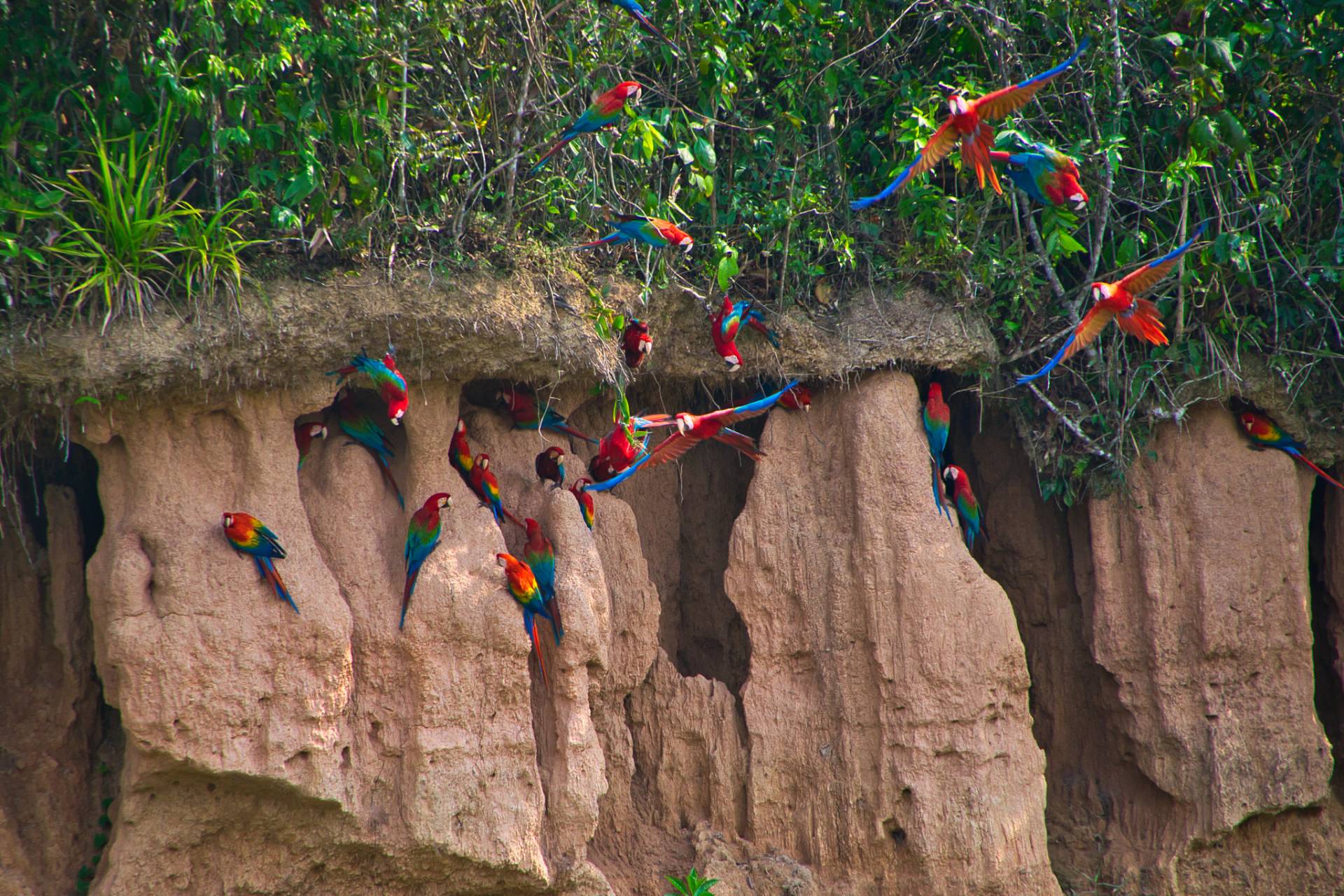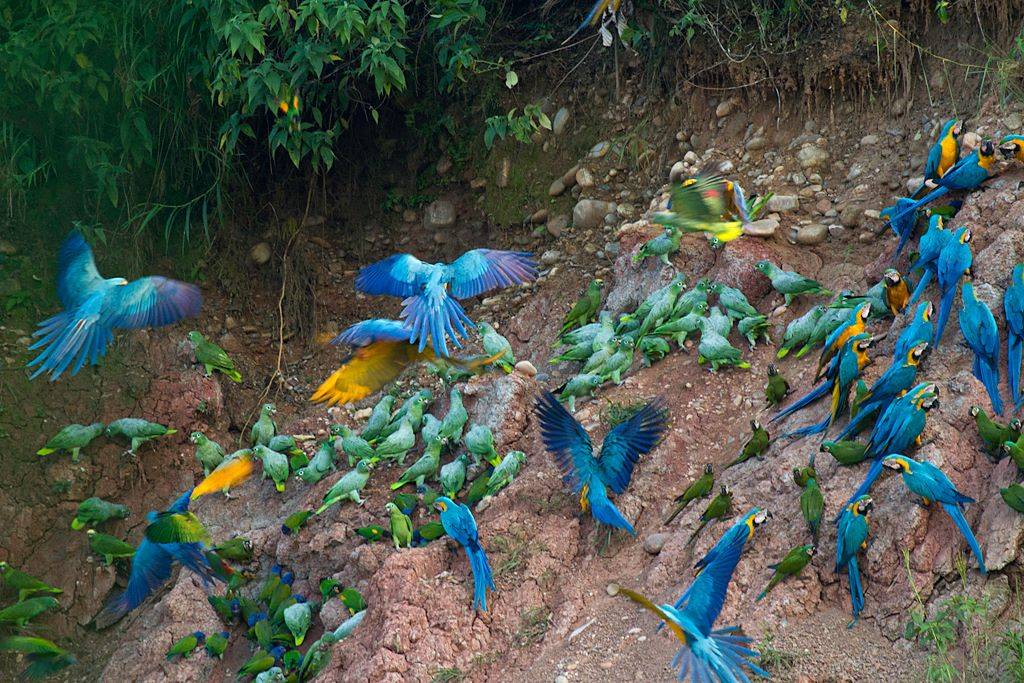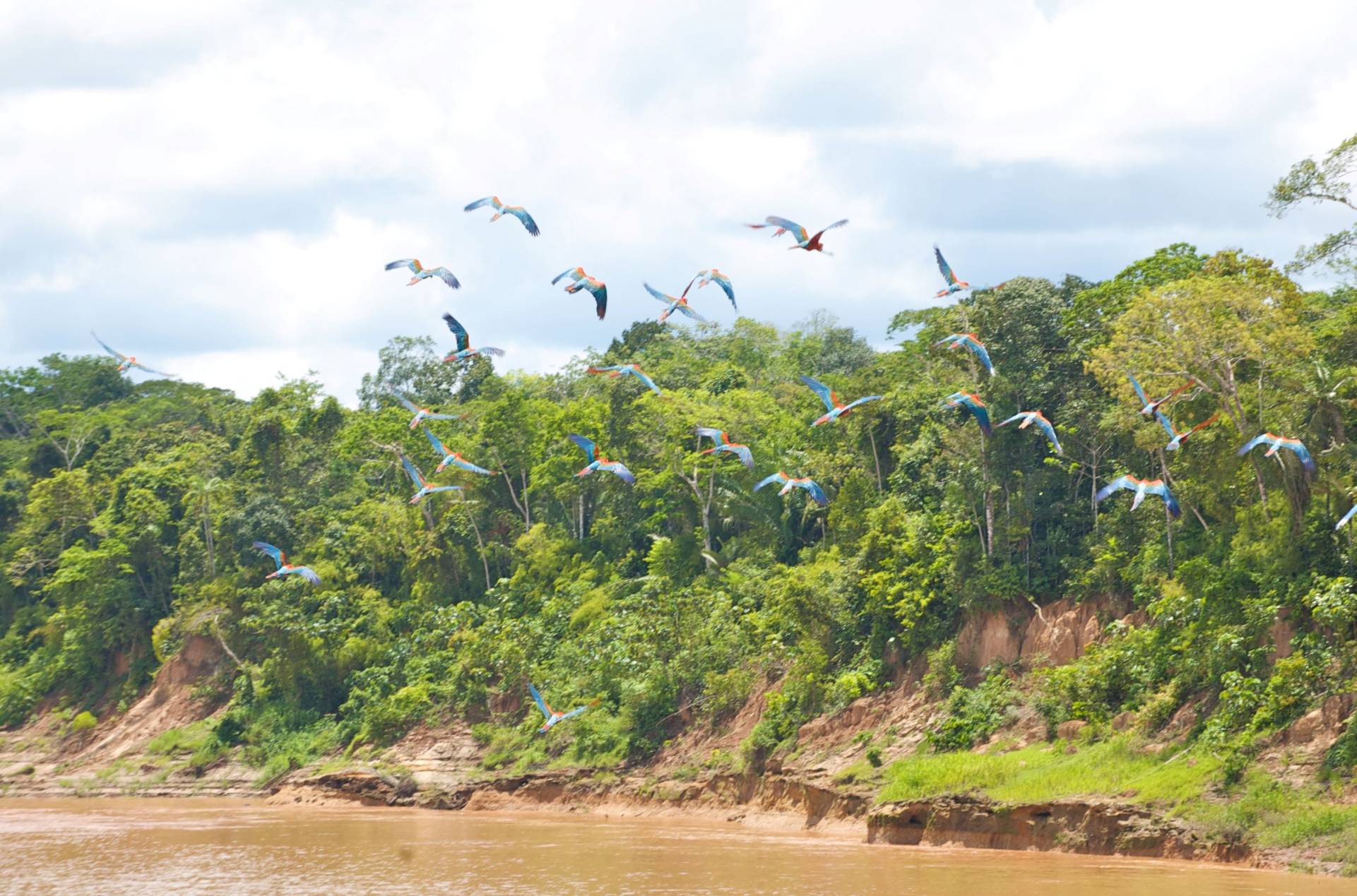For parrot enthusiasts, visiting a macaw and parrot claylick is guaranteed to be one of the most memorable highlights of your trip to the Amazon rainforest.
The Tambopata National Reserve in south-eastern Peru protects the world’s largest known parrot clay lick and the area contains the highest known concentration of them in the world.
A claylick (locally known as colpa or collpa) is a naturally forming wall of clay on a riverbank caused by erosion from the river.
Every morning at around dawn, macaws, amazons, parakeets, parrotlets and other parrots flock to these clay licks to eat clay, sometimes hundreds at a time, creating an incredible wildlife spectacle.
Many theories exist about why parrots consume clay – the most often cited are to provide them with a sodium supplement or to neutralise dietary toxins.
The ritual
Activity at parrot licks typically begins just before sunrise with the first parrots arriving overhead, normally in pairs, while calling loudly to each other and then landing high in the trees surrounding the lick. Presumably they perch high up to check for predators in the area while waiting for others to arrive.
Bit by bit, the trees fill with more and more parrots. After some time, they begin to fly in slow circles in front of the claylick or descend to lower vegetation and once they are certain there are no predators, they flock to the lick in groups to consume clay.
Once they have finished, or if they feel under threat, they will depart in an amazing blur of colour and cacophony of calls.
See When to Visit Tambopata for information on the best months to visit the parrot licks in Tambopata and bear in mind that parrots use claylicks much less on rainy or foggy days.
Avoiding disturbance to the parrots
Some measures are taken by guides and recommended to visitors to avoid disturbing the parrots. First of all, keep in mind that visitors are taken to the claylicks before the parrots arrive, meaning a very early start to the day!
In addition, your guide will ask your group to keep together in a certain area that will be at a considerable distance to the lick itself (for example, at Colpa Colorado, this distance has been set as at least 150 m (500 ft.) and to keep relatively quiet.
The most spectacular clay licks in the Tambopata National Reserve
Collpa Colorado
The Collpa Colorado, otherwise known as the Tambopata Research Centre clay lick, is the largest known parrot claylick in the world and has been featured by various wildlife documentaries and in a National Geographic magazine cover story.
It is approximately 25 – 30 m (82 – 98 ft.) high and 500 m (1,640 ft.) long. It is located very deep in the rainforest in an uninhabited, primary forest area very close to the Tambopata Research Centre and next to the Bahuaja-Sonene National Park.
It is known to attract 17 parrot species, including 6 macaw species, including occasional visits by the very rare Blue-Headed Macaw. The other more common macaw species here are the Red and Green, Chesnut-Fronted, Scarlet, Red-Bellied and Blue and Yellow Macaw.
It takes over 6 hours to arrive here from Puerto Maldonado so visitors generally break up that journey by staying at a jungle lodge on the way for at least one night.
Collpa Chuncho
This is the second largest claylick in the area (and possibly the world) and attracts many different parrot species, including at least three macaw species (Red and Green, Blue and Yellow and Scarlet).
A study of the claylick in 2010 by the Macaw Project found that there were 13 parrot species using it at that time.
It is around 10 m (33 ft.) high and 400 m (1,300 ft.) long. It is located in an uninhabited area half an hour from the furthest control post in the reserve (Malinowski) and five hours by boat from Puerto Maldonado.
Investigation is currently underway to collect more data about the parrots that use this claylick since so far research has been mainly focussed on the Colorado lick.
Other Parrot Colpas
There are various other claylicks along the Tambopata and Madre de Dios Rivers, each one is unique and attracts a different mix of parrots.
- Colpa Hermosa – near the Posada Amazonas lodge, the viewing blind is close to the claylick. Mostly used by parrots and parakeets and is also visited by mammals.
- El Gato – near the only waterfall in the area. Visitors’ blind is 60 metres away. Located near Refugio Amazonas Lodge and Casa Hospedaje El Gato. Mostly used by parrots and parakeets.
- La Torre – also sometimes visited by mammals, close to Explorer’s Inn and Cocococha Lake.
- La Cachuela – just outside Puerto Maldonado.
- Explorer’s Inn – near the lodge with the same name
Accommodation and getting there
The Tambopata National Reserve is close to Puerto Maldonado, in south-eastern Peru. You can book flights to Puerto Maldonado from Cusco or Lima.
Most visitors stay at one of the Amazon jungle lodges dotted along the rivers and either have a visit to a parrot claylick included with their accommodation or they add it to their booking.
The only lodge close to the Collpa Colorado is the Tambopata Research Center.
There are various lodges within boating distance to the other claylicks and some are accessible on a day tour from your hotel or hostel in Puerto Maldonado. Some tours include overnight camping near the claylick.






